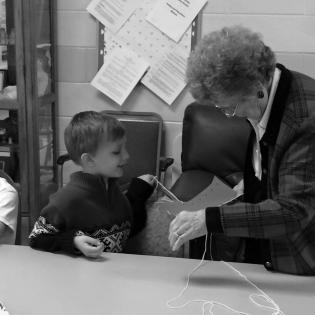Oral History Project
Session One
- Listening, really listening is an act of philanthropy. We are intentionally giving our time to another person when we listen to their stories. To introduce the oral history project, begin by watching the StoryCorps video describing the “Great Thanksgiving Listen.”
- Invite children to think about someone in their life who they like to talk with. How does talking with that person make them feel? After pausing to reflect independently, have children turn and talk with a partner. Then discuss the question as a whole group.
- Next, watch Learning to Give’s video on Philanthropy. Ask children how the two videos are connected. Prompt them to think about ways listening is an act of giving, or generosity.
Session Two
Tell children they are going to be participating in the StoryCorps project by interviewing someone in their life who is generous and community focused, possibly a grandparent or a volunteer they encounter. Have children begin to think about who they might like to interview.
Facilitate this StoryCorps lesson on “Tips for Effective Interviews.” This lesson includes tips for interviews and helps them develop their own set of questions.
Session Three
- Have children name the person they want to interview for their oral history project and write down 4-5 questions to ask, as well as a couple of possible follow-up questions.
- Children conduct interviews in person, over the phone, or on Zoom. They complete the Interview and Reflection handout.
- As a group, have a wrap-up discussion using the following questions: How did conducting the interview make you feel? Were there any responses to your questions that surprised you? If you conducted another StoryCorps interview, what questions would you ask again? What questions would you like to add to your interview?
Note for Remote Classrooms: In a virtual classroom, breakout rooms can be used to facilitate “turn and talk” discussions to increase student engagement as well as a space to conduct practice interviews. In addition, teachers can post videos and discussion questions in their Learning Management Systems for asynchronous learning.
Home Connection
Students under the age of 13 may not add their interviews to the StoryCorps database at the Library of Congress. However, families may choose to submit their conversations to the StoryCorps project using the StoryCorp app. The Interview and Reflection homework handout guides the at-home work.
Teen Version of the Oral History Project
Additional Resources
Books with themes of generosity and philanthropy:
- Ordinary Mary’s Extraordinary Deed by Emily Pearson
- Boxes for Katje by Candice Fleming
Books with the theme of listening
- The Rabbit Listened by Corey Doerrfeld
- I have a Little Problem, Said the Bear by Heinz Janisch
